Proakis-50210
proa-fm
August 9, 2001
14:2
COMMUNICATION SYSTEMS
ENGINEERING
John G. Proakis
Masoud Salehi
2nd Ed.
Upper Saddle River, New Jersey 07458
i
�
Proakis-50210
proa-fm
August 9, 2001
14:2
To Felia, George, and Elena.
—John G. Proakis
To Fariba, Omid, Sina, and my parents.
—Masoud Salehi
Library of Congress Cataloging-in-Publication Data
CIP data available on file.
Vice President and Editorial Director, ECS: Marcia J. Horton
Publisher: Tom Robbins
Editorial Assistant: Jody McDonnell
Vice President and Director of Production and Manufacturing, ESM: David W. Riccardi
Executive Managing Editor: Vince O’Brien
Managing Editor: David A. George
Production Editor: Chanda Wakefield
Director of Creative Services: Paul Belfanti
Creative Director: Carole Anson
Art Director: Jayne Conte
Art Editor: Greg Dulles
Manufacturing Manager: Trudy Pisciotti
Manufacturing Buyer: Lynda Castillo
Marketing Manager: Holly Stark
Marketing Assistant: Karen Moon
c 2002 by Prentice-Hall, Inc.
Upper Saddle River, New Jersey
All rights reserved. No part of this book may be reproduced, in any form
or by any means without permission in writing from the publisher.
Printed in the United States of America
10
9
8
7
5
4
3
6
2
1
ISBN 0-13-061793-8
Pearson Education Ltd., London
Pearson Education Australia Pty. Ltd., Sydney
Pearson Education Singapore, Pte. Ltd.
Pearson Education North Asia Ltd., Hong Kong
Pearson Education Canada, Inc., Toronto
Pearson Educacíon de Mexico, S.A. de C.V.
Pearson Education—Japan, Tokyo
Pearson Education Malaysia, Pte. Ltd.
ii
�
Proakis-50210
proa-fm
August 3, 2001
15:53
Contents
PREFACE
1
INTRODUCTION
1.1
1.2
1.3
1.4
1.5
1.6
Historical Review 1
Elements of an Electrical Communication System 4
1.2.1 Digital Communication System, 7
1.2.2 Early Work in Digital Communications, 10
Communication Channels and Their Characteristics
Mathematical Models for Communication Channels
12
19
Organization of the Book
22
Further Reading
23
2
FREQUENCY DOMAIN ANALYSIS OF SIGNALS
AND SYSTEMS
2.1
2.2
Fourier Series
2.1.1 Fourier Series for Real Signals: the Trigonometric Fourier Series, 29
24
Fourier Transforms
2.2.1 Fourier Transform of Real, Even, and Odd Signals, 35
31
xi
1
24
iii
�
Proakis-50210
proa-fm
August 3, 2001
15:53
iv
Contents
2.3
2.4
2.5
2.6
2.2.2 Basic Properties of the Fourier Transform, 36
2.2.3 Fourier Transform for Periodic Signals, 39
Power and Energy
2.3.1 Energy-Type Signals, 41
2.3.2 Power-Type Signals, 42
40
Sampling of Bandlimited Signals
45
Bandpass Signals
49
Further Reading
57
Problems
57
3
ANALOG SIGNAL TRANSMISSION AND RECEPTION
70
3.1
3.2
3.3
3.4
3.5
3.6
Introduction to Modulation 70
71
Amplitude Modulation (AM)
3.2.1 Double-Sideband Suppressed Carrier AM, 71
3.2.2 Conventional Amplitude Modulation, 78
3.2.3 Single-Sideband AM, 81
3.2.4 Vestigial-Sideband AM, 85
3.2.5 Implementation of AM Modulators and Demodulators, 88
3.2.6 Signal Multiplexing, 94
Angle Modulation 96
3.3.1 Representation of FM and PM Signals, 97
3.3.2 Spectral Characteristics of Angle-Modulated Signals, 101
3.3.3 Implementation of Angle Modulators and Demodulators, 107
Radio and Television Broadcasting
3.4.1 AM Radio Broadcasting, 115
3.4.2 FM Radio Broadcasting, 116
3.4.3 Television Broadcasting, 120
115
Mobile Radio Systems
128
Further Reading
131
Problems
131
4
RANDOM PROCESSES
144
4.1
4.2
Probability and Random Variables
144
159
Random Processes: Basic Concepts
4.2.1 Description of Random Processes, 162
4.2.2 Statistical Averages, 164
4.2.3 Stationary Processes, 166
4.2.4 Random Processes and Linear Systems, 174
�
Proakis-50210
proa-fm
August 3, 2001
15:53
Contents
v
4.3
4.4
4.5
4.6
4.7
Random Processes in the Frequency Domain
4.3.1 Power Spectrum of Stochastic Processes, 177
4.3.2 Transmission over LTI Systems, 183
177
Gaussian and White Processes
4.4.1 Gaussian Processes, 186
4.4.2 White Processes, 188
186
Bandlimited Processes and Sampling
192
Bandpass Processes
194
Further Reading
201
Problems
202
5
EFFECT OF NOISE ON ANALOG COMMUNICATION
SYSTEMS
217
5.1
5.2
5.3
5.4
5.5
Effect of Noise on Linear-Modulation Systems
5.1.1 Effect of Noise on a Baseband System, 218
5.1.2 Effect of Noise on DSB-SC AM, 218
5.1.3 Effect of Noise on SSB AM, 220
5.1.4 Effect of Noise on Conventional AM, 221
217
Carrier-Phase Estimation with a Phase-Locked Loop (PLL) 225
5.2.1 The Phase-Locked Loop (PLL), 226
5.2.2 Effect of Additive Noise on Phase Estimation, 229
Effect of Noise on Angle Modulation
5.3.1 Threshold Effect in Angle Modulation, 244
5.3.2 Pre-emphasis and De-emphasis Filtering, 248
234
Comparison of Analog-Modulation Systems
251
Effects of Transmission Losses and Noise in Analog
Communication Systems
5.5.1 Characterization of Thermal Noise Sources, 253
5.5.2 Effective Noise Temperature and Noise Figure, 254
5.5.3 Transmission Losses, 257
5.5.4 Repeaters for Signal Transmission, 258
252
5.6
Further Reading
261
Problems
261
6
INFORMATION SOURCES AND SOURCE CODING
267
6.1
Modeling of Information Sources
6.1.1 Measure of Information, 269
6.1.2 Joint and Conditional Entropy, 271
268
�
Proakis-50210
proa-fm
August 3, 2001
15:53
vi
Contents
6.2
6.3
6.4
6.5
6.6
6.7
6.8
Source-Coding Theorem 273
Source-Coding Algorithms 276
6.3.1 The Huffman Source-Coding Algorithm, 276
6.3.2 The Lempel-Ziv Source-Coding Algorithm, 280
Rate-Distortion Theory
282
6.4.1 Mutual Information, 283
6.4.2 Differential Entropy, 284
6.4.3 Rate-Distortion Function, 285
Quantization 290
6.5.1 Scalar Quantization, 291
6.5.2 Vector Quantization, 300
302
Waveform Coding
6.6.1 Pulse-Code Modulation (PCM), 302
6.6.2 Differential Pulse-Code Modulation (DPCM), 307
6.6.3 Delta Modulation (�M), 310
Analysis-Synthesis Techniques 312
Digital Audio Transmission and Digital Audio Recording
6.8.1 Digital Audio in Telephone Transmission Systems, 317
6.8.2 Digital Audio Recording, 319
316
6.9
The JPEG Image-Coding Standard
323
6.10
Further Reading
327
Problems
327
7
DIGITAL TRANSMISSION THROUGH THE ADDITIVE WHITE
GAUSSIAN NOISE CHANNEL
340
7.1
7.2
7.3
7.4
Geometric Representation of Signal Waveforms
341
Pulse Amplitude Modulation 345
Two-dimensional Signal Waveforms
7.3.1 Baseband Signals, 350
7.3.2 Two-dimensional Bandpass Signals—Carrier-Phase Modulation, 354
7.3.3 Two-dimensional Bandpass Signals—Quadrature Amplitude
350
Modulation, 357
Multidimensional Signal Waveforms
7.4.1 Orthogonal Signal Waveforms, 360
7.4.2 Biorthogonal Signal Waveforms, 365
7.4.3 Simplex Signal Waveforms, 366
7.4.4 Binary-Coded Signal Waveforms, 367
360
�
Proakis-50210
proa-fm
August 3, 2001
15:53
Contents
7.5
7.6
7.7
7.8
vii
370
Optimum Receiver for Digitally Modulated Signals in Additive White
Gaussian Noise
7.5.1 Correlation-Type Demodulator, 370
7.5.2 Matched-Filter-Type Demodulator, 375
7.5.3 The Optimum Detector, 381
7.5.4 Demodulation and Detection of Carrier-Amplitude Modulated
Signals, 386
7.5.5 Demodulation and Detection of Carrier-Phase Modulated Signals, 388
7.5.6 Demodulation and Detection of Quadrature Amplitude Modulated
Signals, 396
7.5.7 Demodulation and Detection of Frequency-Modulated Signals, 398
405
Probability of Error for Signal Detection in Additive White
Gaussian Noise
7.6.1
7.6.2
7.6.3
7.6.4
7.6.5
7.6.6
7.6.7
7.6.8
7.6.9
7.6.10 Comparison of Modulation Methods, 432
Probability of Error for Binary Modulation, 405
Probability of Error for M-ary PAM, 408
Probability of Error for Phase-Coherent PSK Modulation, 413
Probability of Error for DPSK, 417
Probability of Error for QAM, 418
Probability of Error for M-ary Orthogonal Signals, 423
Probability of Error for M-ary Biorthogonal Signals, 428
Probability of Error for M-ary Simplex Signals, 429
Probability of Error for Noncoherent Detection of FSK, 430
Performance Analysis for Wireline and Radio Communication
Channels 436
7.7.1 Regenerative Repeaters, 437
7.7.2 Link Budget Analysis for Radio Channels, 438
Symbol Synchronization 442
7.8.1 Early–Late Gate Synchronizers, 443
7.8.2 Minimum Mean-Square-Error Method, 445
7.8.3 Maximum-Likelihood Methods, 448
7.8.4 Spectral Line Methods, 449
7.8.5 Symbol Synchronization for Carrier-Modulated Signals, 451
7.9
Further Reading
452
Problems
453
8
DIGITAL TRANSMISSION THROUGH BANDLIMITED
AWGN CHANNELS
474
8.1
Digital Transmission through Bandlimited Channels
474
8.1.1 Digital PAM Transmission through Bandlimited Baseband
Channels, 478
8.1.2 Digital Transmission through Bandlimited Bandpass Channels, 480
�
Proakis-50210
proa-fm
August 3, 2001
15:53
viii
Contents
8.2
8.3
8.4
8.5
8.6
8.7
8.8
The Power Spectrum of Digitally Modulated Signals 482
8.2.1 The Power Spectrum of the Baseband Signal, 483
8.2.2 The Power Spectrum of a Carrier-Modulated Signal, 488
Signal Design for Bandlimited Channels
8.3.1 Design of Bandlimited Signals for Zero ISI—The Nyquist Criterion, 492
8.3.2 Design of Bandlimited Signals with Controlled ISI—Partial Response
490
Signals, 497
Probability of Error in Detection of Digital PAM 499
8.4.1 Probability of Error for Detection of Digital PAM with Zero ISI, 500
8.4.2 Symbol-by-Symbol Detection of Data with Controlled ISI, 501
8.4.3 Probability of Error for Detection of Partial Response Signals, 504
Digitally Modulated Signals with Memory
8.5.1 Modulation Codes and Modulation Signals with Memory, 508
8.5.2 The Maximum-Likelihood Sequence Detector, 521
8.5.3 Maximum-Likelihood Sequence Detection of Partial Response
507
Signals, 525
8.5.4 The Power Spectrum of Digital Signals with Memory, 530
System Design in the Presence of Channel Distortion
8.6.1 Design of Transmitting and Receiving Filters for a Known Channel, 535
8.6.2 Channel Equalization, 538
534
Multicarrier Modulation and OFDM 556
8.7.1 An OFDM System Implemented via the FFT Algorithm, 557
Further Reading
560
Problems
561
9
CHANNEL CAPACITY AND CODING
576
9.1
9.2
9.3
9.4
9.5
9.6
Modeling of Communication Channels
576
Channel Capacity
9.2.1 Gaussian Channel Capacity, 583
579
Bounds on Communication 586
9.3.1 Transmission of Analog Sources by PCM, 590
Coding for Reliable Communication 591
9.4.1 A Tight Bound on Error Probability of Orthogonal Signals, 592
9.4.2 The Promise of Coding, 595
Linear Block Codes
9.5.1 Decoding and Performance of Linear Block Codes, 606
9.5.2 Burst-Error-Correcting-Codes, 614
601
Cyclic Codes
9.6.1 The Structure of Cyclic Codes, 615
615
�


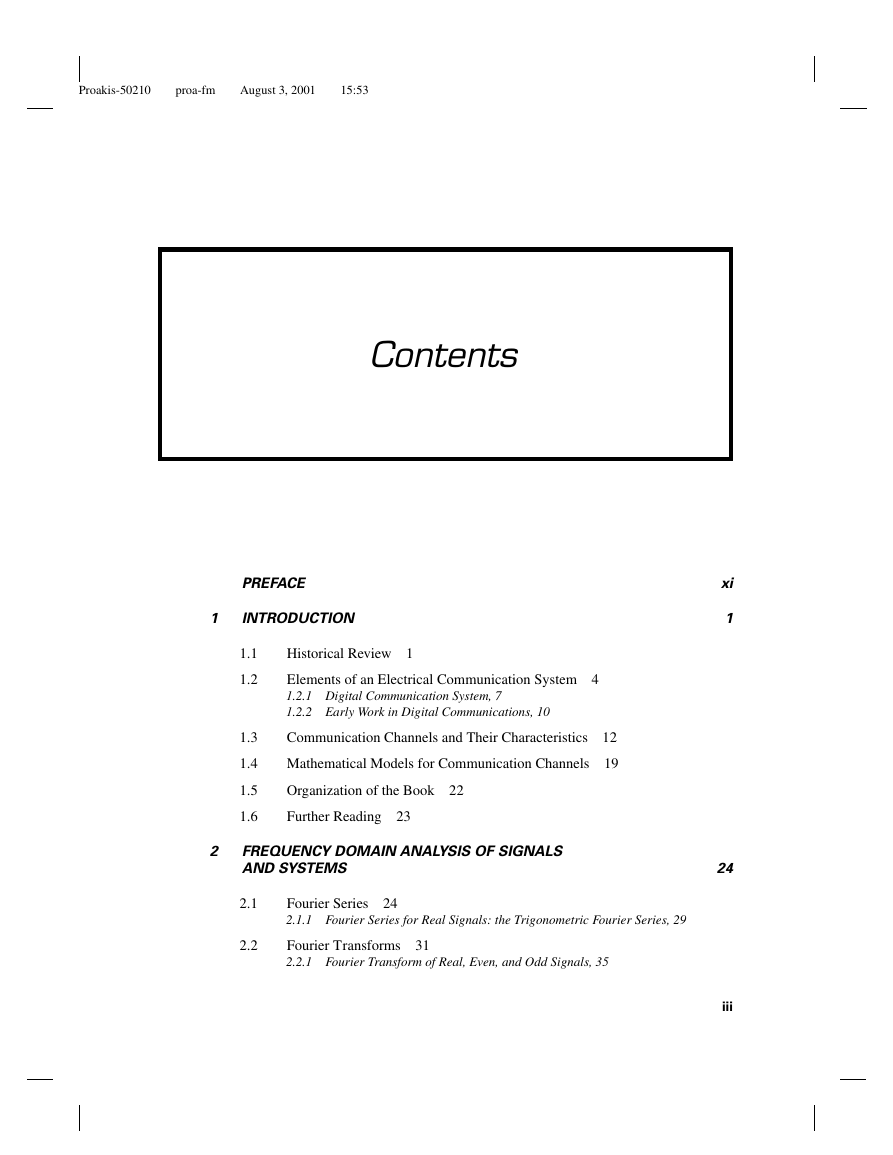
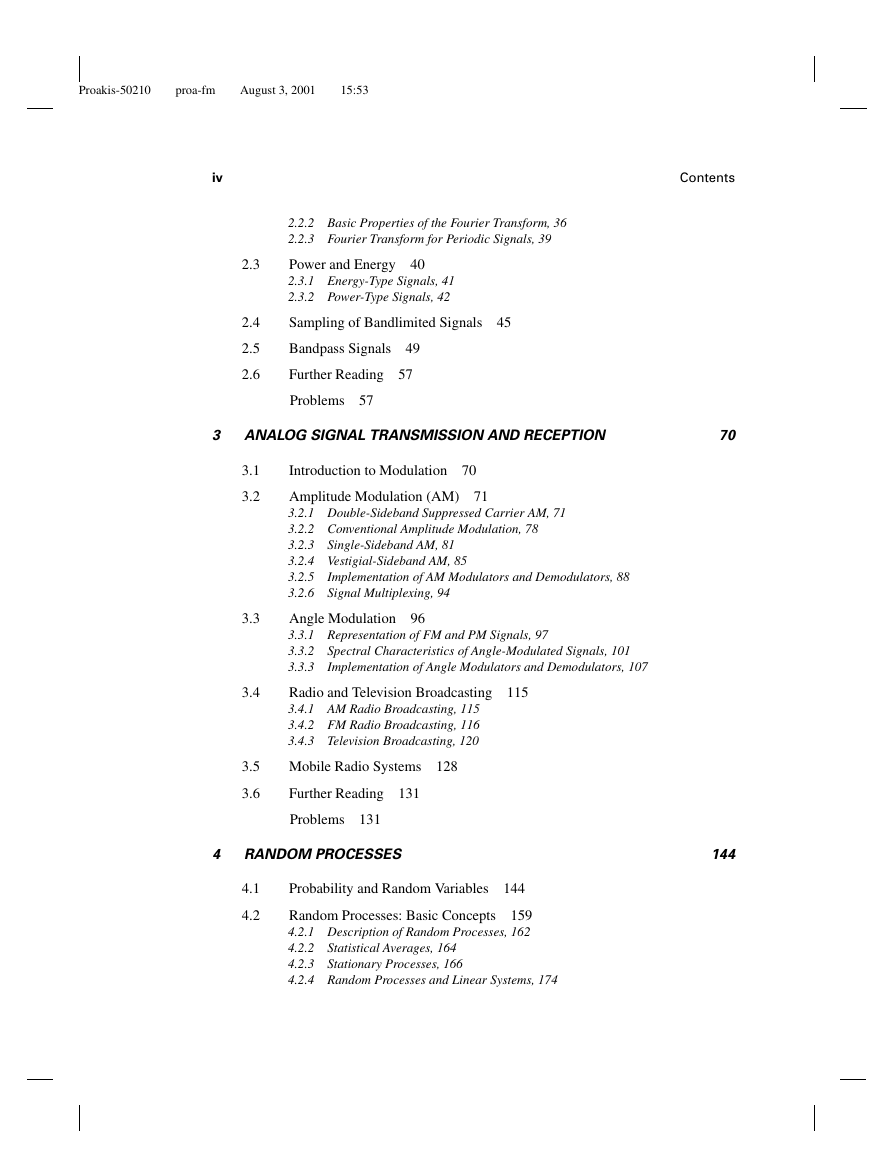
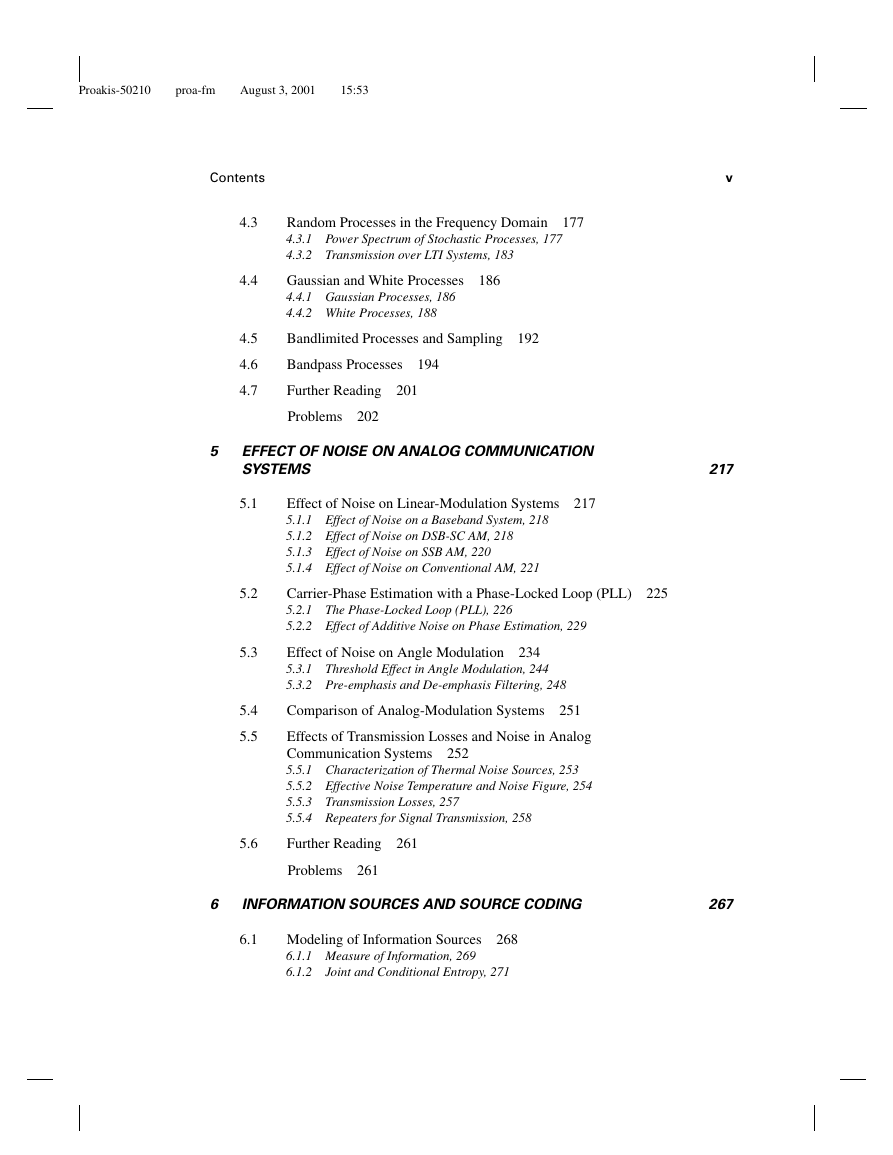
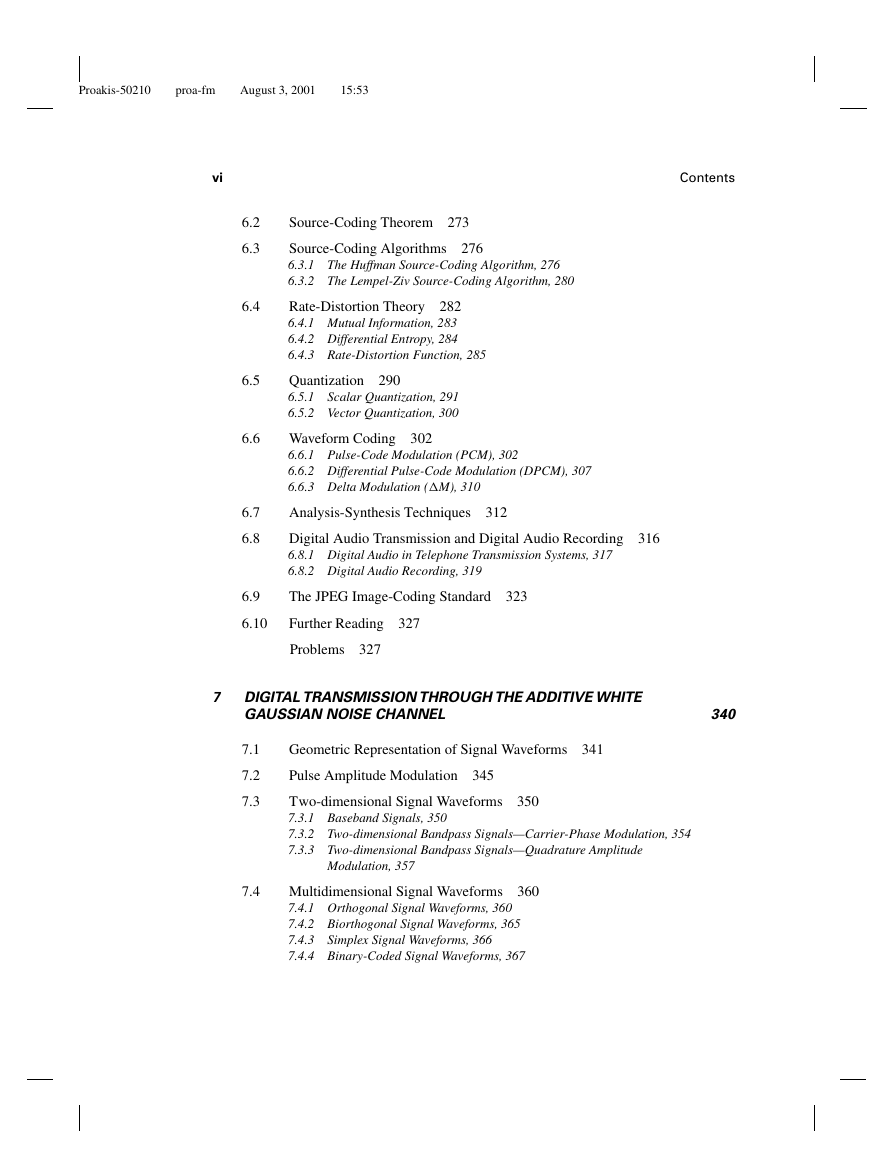
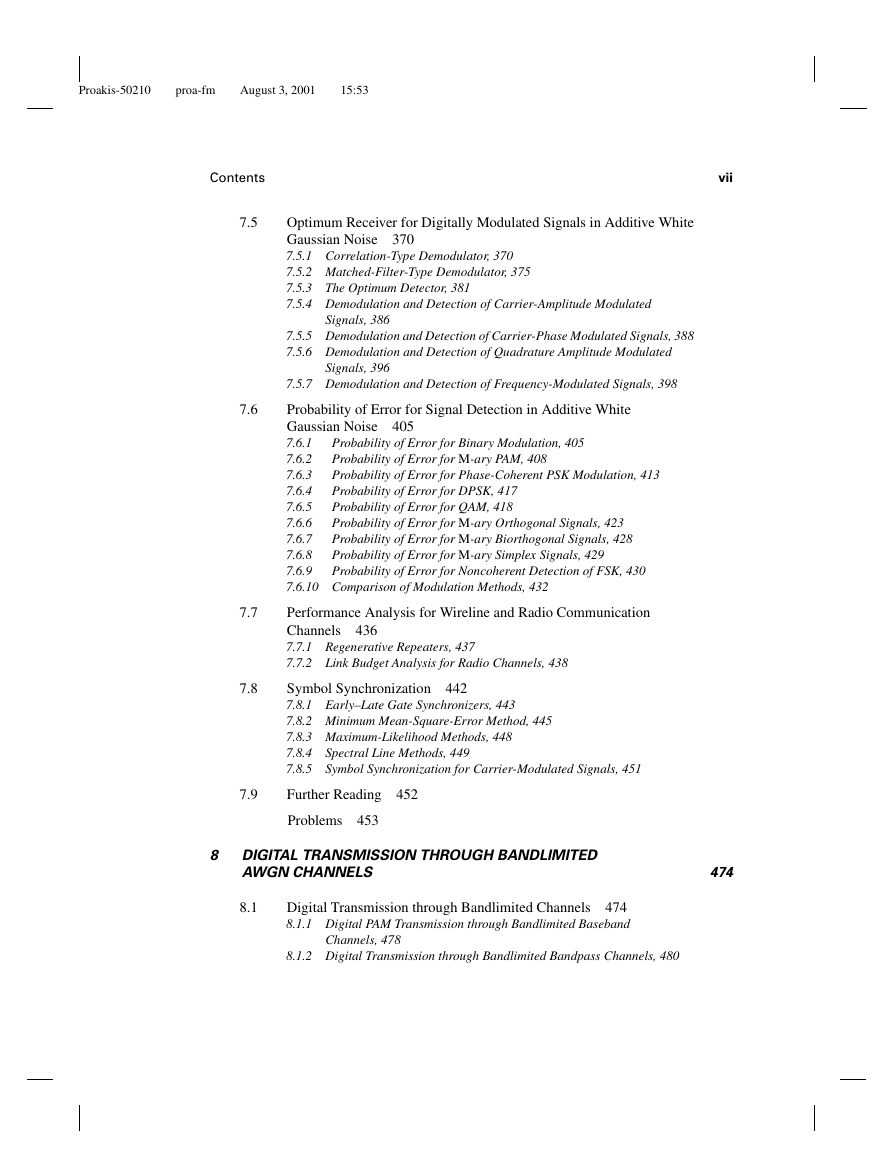









 2023年江西萍乡中考道德与法治真题及答案.doc
2023年江西萍乡中考道德与法治真题及答案.doc 2012年重庆南川中考生物真题及答案.doc
2012年重庆南川中考生物真题及答案.doc 2013年江西师范大学地理学综合及文艺理论基础考研真题.doc
2013年江西师范大学地理学综合及文艺理论基础考研真题.doc 2020年四川甘孜小升初语文真题及答案I卷.doc
2020年四川甘孜小升初语文真题及答案I卷.doc 2020年注册岩土工程师专业基础考试真题及答案.doc
2020年注册岩土工程师专业基础考试真题及答案.doc 2023-2024学年福建省厦门市九年级上学期数学月考试题及答案.doc
2023-2024学年福建省厦门市九年级上学期数学月考试题及答案.doc 2021-2022学年辽宁省沈阳市大东区九年级上学期语文期末试题及答案.doc
2021-2022学年辽宁省沈阳市大东区九年级上学期语文期末试题及答案.doc 2022-2023学年北京东城区初三第一学期物理期末试卷及答案.doc
2022-2023学年北京东城区初三第一学期物理期末试卷及答案.doc 2018上半年江西教师资格初中地理学科知识与教学能力真题及答案.doc
2018上半年江西教师资格初中地理学科知识与教学能力真题及答案.doc 2012年河北国家公务员申论考试真题及答案-省级.doc
2012年河北国家公务员申论考试真题及答案-省级.doc 2020-2021学年江苏省扬州市江都区邵樊片九年级上学期数学第一次质量检测试题及答案.doc
2020-2021学年江苏省扬州市江都区邵樊片九年级上学期数学第一次质量检测试题及答案.doc 2022下半年黑龙江教师资格证中学综合素质真题及答案.doc
2022下半年黑龙江教师资格证中学综合素质真题及答案.doc